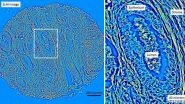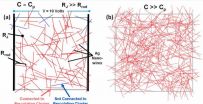(Press-News.org) Washington, DC (May 17, 2015) -- While a new generation of safer, more effective oral medications to treat hepatitis C patients may cost tens of thousands of dollars for a 12-week regiment, investing in these new therapies could generate savings estimated at more than $3.2 billion annually in the U.S. and five European countries, according to a new study (abstract 228) released today at Digestive Disease Week® (DDW) 2015. These savings would have a significant economic impact on society.
The higher cure rate and lessened side-effects of treating patients with an all-oral combination of ledipasvir and sofosbuvir (LDV/SOF) results in greatly reduced absenteeism and improved workplace productivity that can translate into enormous benefit, according to the new economic model used by researchers at Inova Fairfax Medical Campus, VA.
"From a clinical standpoint, we've long known about the devastating health impacts that chronic hepatitis C has on a patient," said Zobair Younossi, MD, chairman of the department of medicine at Inova and lead researcher on the study. "But given the significant side-effects previously associated with treating the disease, notably fatigue and neuropsychiatric side effects, we were interested in looking at the impact of new treatments on patients' ability to work, and in a broader sense, how this effects employers and overall economies."
Researchers used data collected from more than 1,900 chronic hepatitis C patients treated with LDV/SOF, which has a cure rate of between 94 and 99 percent with minimal side effects. Older traditional treatments that included interferon and ribavirin were less effective and caused a variety of side effects, including fatigue, as well as flu-like symptoms, depression and lowered blood cell counts.
Patients from the U.S. and Europe filled out questionnaires called the "Work Productivity and Activity Index - Specific Health Problems During Clinical Trials of LDV/SOF." The retrospective study tabulated reported absenteeism, as well as what researchers called "presenteeism," a measure of how productive an individual actually is while at work.
The researchers then built an economic model to estimate work productivity gains associated with curing genotype-1 chronic hepatitis C patients using LDV/SOF. The models were created for the U.S. and five European countries -- France, Germany, Italy, Spain and the United Kingdom (EU-5). The results indicated that reduced absenteeism and increased productivity would total approximately $2.67 billion for the U.S. and $556 million for the EU-5.
Dr. Younossi stressed that while these preliminary results are encouraging, he plans to conduct further research to examine data outside of the clinical trial setting in order to evaluate the real-world consequences of a hepatitis C cure on work productivity and associated economic gains. He believes that researchers are beginning to see the bigger picture when it comes to the impact of hepatitis C, which can cause severe liver damage and other long-term health effects called the "extrahepatic manifestations of the hepatitis C virus."
"Chronic hepatitis C is more than just a problem for the patient -- it has a ripple effect that impacts society at large. While previous reports have found the cost of these drugs as certainly significant, the long term benefits of curing patients with hepatitis C makes this a worthwhile investment. We must begin to look at chronic diseases, such as hepatitis C, from every angle, which should inspire progress in developing more tolerable and effective cures," added Dr. Younossi.
On Sunday, May 17 at 1 p.m. ET, join DDW for a Twitter chat on hepatitis C by using the hashtag #DDW15Chat.
Dr. Zobair Younossi will present data from the study "The Impact of Sustained Viral Eradication on the Work Productivity of Patients with Chronic Hepatitis C (CHC) from the Five Western European Countries and the United States," abstract 228, on Sunday, May 17, at 8:30 a.m. ET, in room 206 of Walter E. Washington Convention Center. This study was funded through a grant provided by Gilead Sciences, Inc. For more information about featured studies, as well as a schedule of availability for featured researchers, please visit http://www.ddw.org/press. Faculty disclosures can be found online at http://www.ddw.org/DDW_Disclosure_Index.pdf.
INFORMATION:
Digestive Disease Week® (DDW) is the largest international gathering of physicians, researchers and academics in the fields of gastroenterology, hepatology, endoscopy and gastrointestinal surgery. Jointly sponsored by the American Association for the Study of Liver Diseases (AASLD), the American Gastroenterological Association (AGA) Institute, the American Society for Gastrointestinal Endoscopy (ASGE) and the Society for Surgery of the Alimentary Tract (SSAT), DDW takes place May 16-19, 2015, at Walter. E. Washington Convention Center, Washington, DC. The meeting showcases more than 5,000 abstracts and hundreds of lectures on the latest advances in GI research, medicine and technology. More information can be found at http://www.ddw.org.
Follow us on Twitter @DDWMeeting; hashtag #DDW15. Become a fan of DDW on Facebook.
The American Cancer Society estimated that 220,800 new cases of prostate cancer will be diagnosed in the United States in 2015. Approximately 27,540 men will die of the disease, accounting for 5 percent of all cancer deaths.
A common treatment for prostate cancer is a prostatectomy, in which all or part of the prostate gland is removed. Recent studies have shown that this procedure is often over-prescribed. As early as 2010, the New England Journal of Medicine reported that such a procedure extended the lives of just 1 patient in 48. Side effects from the surgery, including ...
We all know intuitively that normal liquids flow more quickly as the channel containing them tightens. Think of a river flowing through narrow rapids.
But what if a pipe were so amazingly tiny that only a few atoms of superfluid helium could squeeze through its opening at once? According to a longstanding quantum-mechanics model, the superfluid helium would behave differently from a normal liquid: far from speeding up, it would actually slow down.
For more than 70 years, scientists have been studying the flow of helium through ever smaller pipes. But only recently ...
The MODIS instrument on the Aqua satellite captured this image of the Little Bobtail Lake fire in British Columbia, Canada. It is unclear how the fire started and was first spotted on Saturday, May 9. Since then the fire has grown significantly and has burned over 13,000 hectares (32,123 acres) and is zero percent con The wildfire is located about 70 km southwest of Prince George. Eighty people have already been evacuated and close to 700 homes are in danger of being consumed should the fire spread.
British Columbia Wildfire Management reports that the fire is unpredictable ...
Washington D.C. - Friday, May 15, 2015- Investigators found that nearly half of the 50 chicken meat samples purchased from supermarkets, street markets, and butchers in Austria contained viruses that are capable of transferring antibiotic resistance genes from one bacterium to another--or from one species to another. "Our work suggests that such transfer could spread antibiotic resistance in environments such as food production units and hospitals and clinics," said corresponding author Friederike Hilbert, DVM. The research is published ahead of print May 1, in Applied ...
At the forefront of a field known as "neurocriminology," Adrian Raine of the University of Pennsylvania has long studied the interplay between biology and environment when it comes to antisocial and criminal behavior. With strong physiological evidence that disruption to the emotion-regulating parts of the brain can manifest in violent outbursts, impulsive decision-making and other behavioral traits associated with crime, much of Raine's research involves looking at biological interventions that can potentially ward off these behavioral outcomes.
A new study by Raine ...
An article, "Smaller amygdala and medial prefrontal cortex predict escalating stimulant use," published online on May 13 in Brain: A Journal of Neurology has found that individual differences in brain structure could help to determine the risk for future drug addiction. The study found that occasional users who subsequently increased their drug use compared with those who did not, showed brain structural differences when they started using drugs.
In the two studies, researchers, led by Dr. Benjamin Becker, scanned the brain structure of 66 participants to provide the ...
NEW YORK, May 15, 2015 -- National thought leaders convened at Columbia University's Mailman School of Public Health yesterday for a symposium identifying gaps in understanding the prevention of sexual violence on college campuses, calling for a broad interdisciplinary agenda for the next generation of research on a significant problem that became front-page news around the country this year.
The day-long event, "Transforming the Campus Climate: Interdisciplinary Perspectives on Sexual Violence," was one of the first public activities sponsored by the Sexual Health Initiative ...
The future of communities around the world will in large part be determined by the efforts to achieve a high quality of life for their older citizens, according to the latest issue of Public Policy & Aging Report (PP&AR), titled "Making a Home in the City: The Age-Friendly Community Movement." A total of seven articles argue that developing cities that meet the interests of all generations should be an important goal for economic and social policy.
"The concomitant growth of cities and of an older population within those cities has come to generate a disjuncture between ...
Boulder, Colo., USA - California and other parts of the western U.S. are experiencing extended severe drought conditions. Varying groundwater levels in valleys throughout the state, balanced by water imported, for instance, via the State Water Project and the federal Central Valley Project make understanding the state's underlying hydrologic framework all the more important. This paper by R.T. (Randy) Hanson of the U.S. Geological Survey focuses on California's Santa Clara Valley.
In the introduction to his paper, Hanson provides a succinct history of the area, as paraphrased ...
Researchers at Lehigh University have identified for the first time that a performance gain in the electrical conductivity of random metal nanowire networks can be achieved by slightly restricting nanowire orientation. The most surprising result of the study is that heavily ordered configurations do not outperform configurations with some degree of randomness; randomness in the case of metal nanowire orientations acts to increase conductivity.
The study, Conductivity of Nanowire Arrays under Random and Ordered Orientation Configurations, is published in the current issue ...



